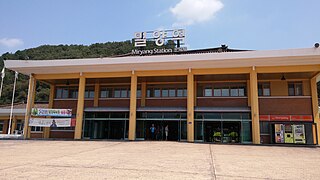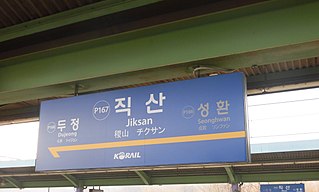
The Gyeongbu line (Gyeongbuseon) is a railway line in South Korea and is considered to be the most important and one of the oldest ones in the country. It was constructed in 1905, connecting Seoul with Busan via Suwon, Daejeon, and Daegu. It is by far the most heavily travelled rail line in South Korea.

The Gyeongin Line (Gyeonginseon) is a railway mainline in South Korea, currently connecting Guro station in Seoul and Incheon. Commuter services along the line through operates into Seoul Subway Line 1.

The Gaya Line is a railway line of Korail in Busan Metropolitan City, South Korea, connecting Sasang on the Gyeongbu Line with Beom-il on the Donghae Line via Gaya, where the line also connects to the Bujeon Line.

Seoul Subway Line 1 of the Seoul Metropolitan Subway is a rapid transit and commuter rail line which links central Seoul, South Korea to Soyosan Station in the northeast, Incheon in the southwest, and Sinchang via Suwon and Cheonan in the south. The central underground portion of Line 1, running underneath Sejongno, Jongno, and Wangsan-ro avenues along Seoul's traditional downtown area, is the oldest subway-operated section in the Seoul Metropolitan Subway system. Its branches and services cover a large part of the Seoul Capital Area; totaling 200.60 km (124.65 mi) in route length.

Dongdaegu Station, meaning "East Daegu Station", is a railway station in Daegu, South Korea. It is on the national high-speed KTX railway network, 282 km (175 mi) south of Seoul Station.

The Mugunghwa-ho is a class of train operated by Korail, main railway operator of South Korea. Mugunghwa trains are Korail's slowest tier of trains stopping at a number of towns and villages, and operating over a number of lines that are not served by other trains. Journey times are generally well over double that of KTX trains and 25% longer than express trains. In 1980, new express train, named 우등, was introduced. Soon it was renamed as Mugunghwa-ho, which was a name of an express train operated in the 1960s. Since train classes below Mugunghwa had been retired, thus Mugunghwa trains are now the cheapest class of trains to operate cross-country. Along rural lines such as the Gyeongbuk Line, they remain the only class of passenger train operating. They are the only trains to stop at many stations not served by Saemaeul-ho or KTX trains. Mugunghwa are built to accommodate large numbers of standing passengers, and frequently have many more standees than sitting passengers.

Suwon Station is a railway station in the city of Suwon, South Korea. The station was completely redeveloped in 2002 and 2003, and is now integrated with the Aekyung Shopping Mall. This station serves Inter-city railway Gyeongbu Line KTX, ITX-Saemaeul and Mugunghwa will stop. Also Line 1, Suin–Bundang Line of the Seoul subway will stop. And this station is an important hub in southern Gyeonggi Province.

Gupo station is a Korail station on the Gyeongbu Line, between Hwamyeong station and Sasang station, located in northern Busan, South Korea. It was opened on 1 January 1905, and is connected with the subway Gupo station on Busan Metro Line 3 via an overhead bridge, so passengers can transfer.

Cheonan Station is the main train station in central Cheonan, South Korea, and the junction of the Gyeongbu and Janghang Lines. It has also been served by Seoul Subway Line 1 since 2005.

Cheonan–Asan station is a ground-level train station located mostly in Asan, Chungcheongnam-do, although part of it lies in the neighboring city of Cheonan. This station serves high-speed KTX trains that run from Seoul to either Busan or Mokpo. It is connected to Asan station, a railway station on the Janghang Line which is also served by Line 1 of the Seoul Subway.

The Gyeongbu high-speed railway, also known as Gyeongbu HSR, is South Korea's first high-speed rail line from Seoul to Busan. KTX high-speed trains operate three sections of the line: on April 1, 2004, the first between a junction near Geumcheon-gu Office station, Seoul and a junction at Daejeonjochajang station north of Daejeon, and a second between a junction at Okcheon station, southeast of Daejeon, and a junction near Jicheon station, north of Daegu entered service; then on November 1, 2010, the third section, between a junction west of Daegu and Busan became operational. The missing gaps across the urban areas of Daejeon and Daegu were in construction for an expected opening in 2014, separate tracks into Seoul Station were also planned. The temporary ends of the three sections were connected to the parallel conventional Gyeongbu Line by tracks that will serve as interconnector branches upon the completion of the entire line. On August 1, 2015, construction on urban areas of Daejeon and Daegu were completed; all the sections of HSR line were connected.

The Honam high-speed railway, also known as Honam HSR, is a high-speed rail between Osong and Mokpo in South Korea. The line is a part of Korail's Korea Train Express (KTX) system, accelerating Seoul–Mokpo and Seoul–Gwangju KTX high-speed services which currently use the existing conventional Honam Line. On April 1, 2015, the line was inaugurated by the South Korean President Park Geun-hye with the attendance of 1200 invited guests and members of the public at Gwangju Songjeong Station in Gwangju, the line's terminus. The line diverges from Osong station on the Gyeongbu high-speed railway, and stops at Gongju, Iksan, Jeongeup Stations. Journey times between Seoul and Gwangju has been cut from 2 h 40 min to just 90 min, making daily commuting possible. The Honam HSR is intended to bring business, and economic opportunities to the province of Jeollanam-do, which has seen slower development than other parts of South Korea. The line has been open to the public since April 2, 2015 for revenue service.

Daejeon Station is on South Korea's high-speed KTX railway network, 166.6 km south of Seoul Station.

Miryang station is on the normal speed Gyeongbu Line, 55 km south of Dongdaegu Station. Miryang station is an important branch of the Gyeongbu and Gyeongjeon lines. The surrounding area is filled with numerous tourist attractions such as Ice Valley, Pyochungsa Temple, Pyochungbi, Jaejak Mountain and Unmun Mountain, as well as famous mountains called Yeongnam Alps. Especially in summer, there is a theater festival held in Miryang Theater Village and a cool ice valley without long clothes. It is a station that is the center of economy and tourism.

Jiksan Station is a station on the Gyeongbu Line in the city of Cheonan in Chungcheongnam-do, South Korea. It is served by trains on Seoul Subway Line 1.

Iwon station is a railway station on the Gyeongbu Line in South Korea. It is located at Gangcheong-ri, Iwon-myeon, Okcheon-gun, Chungcheongbuk Province. It crosses the Gyeongbu Line which is managed by KORAIL. The station also operates trains on an interim basis for a memorial for railroad workers who died, which is located nearby.

Daegu station is a station on the Gyeongbu Line and Daegu Metro Line 1 in Chilseong-dong, Buk District, Daegu, South Korea.

Namseonghyeon station is a railway station on the Gyeongbu Line in South Korea.

The KTX-I, also known as the TGV-K or Korail Class 100000, is a South Korean high speed train class based on the French TGV Réseau. The 20-car formation of the trainsets without restaurant car is optimized for high capacity. The 46 trainsets were built partly in France and partly in South Korea in the framework of a technology transfer agreement, which was the basis for further domestic high-speed train development in South Korea.
High-speed rail service in South Korea began with the construction of a high-speed line from Seoul to Busan in 1992, and was inspired by Japan's Shinkansen. The first commercial high-speed rail service was launched on April 1, 2004. Currently, South Korea hosts two high-speed rail operators: Korea Train eXpress (KTX) and Super Rapid Train (SRT).



















